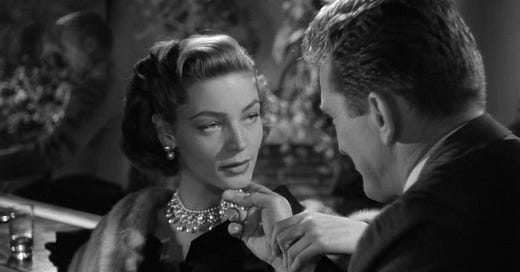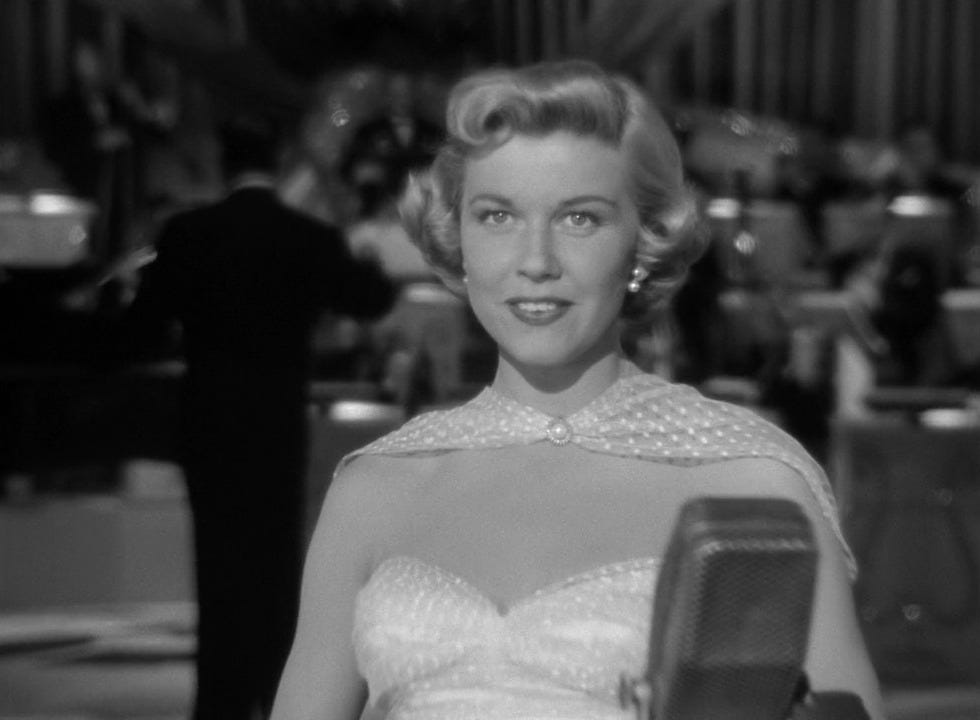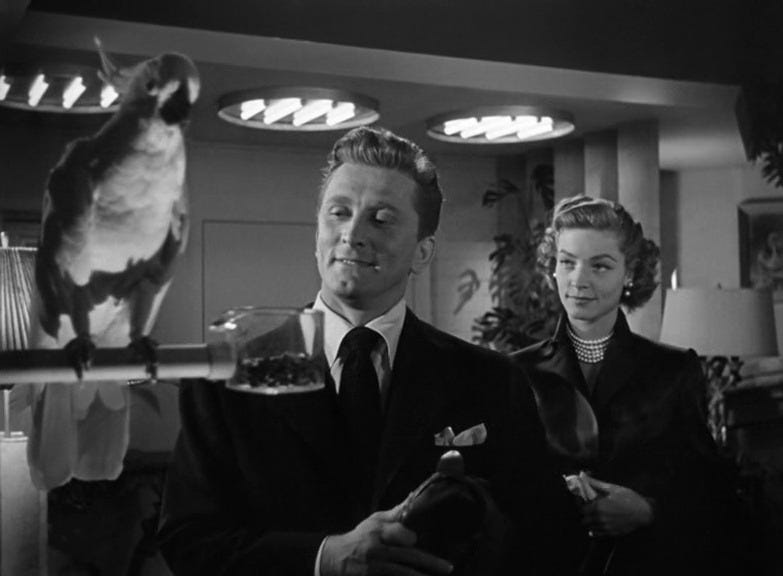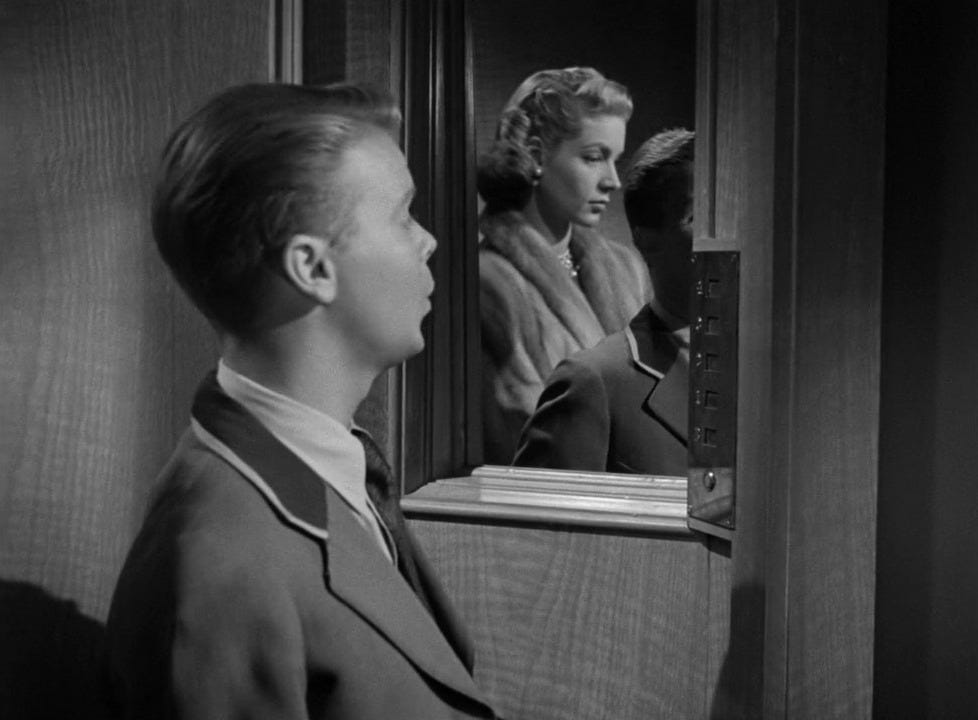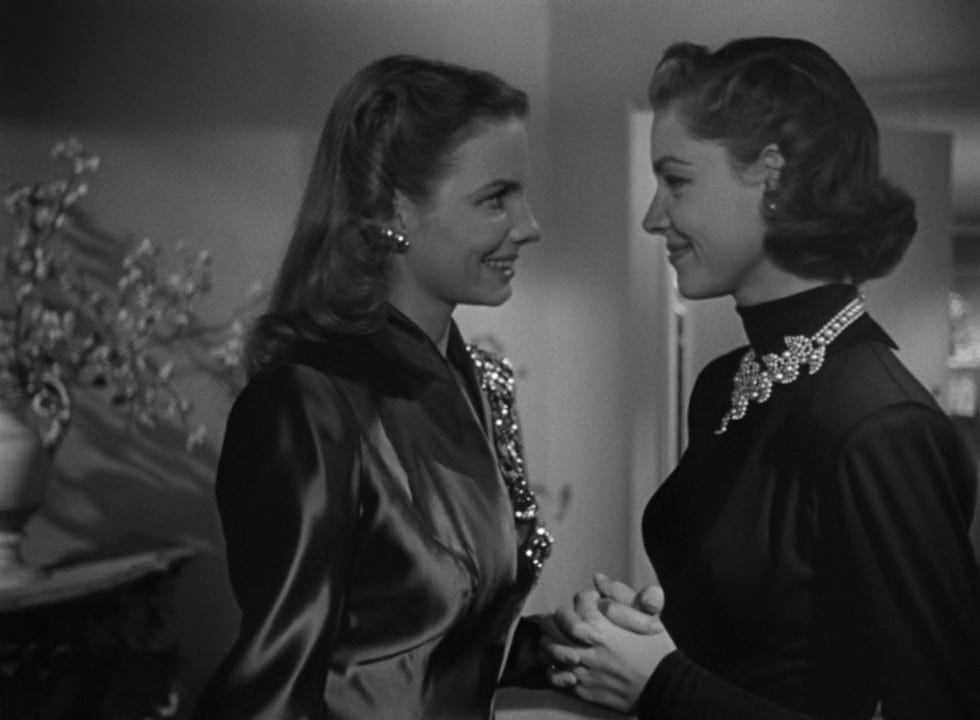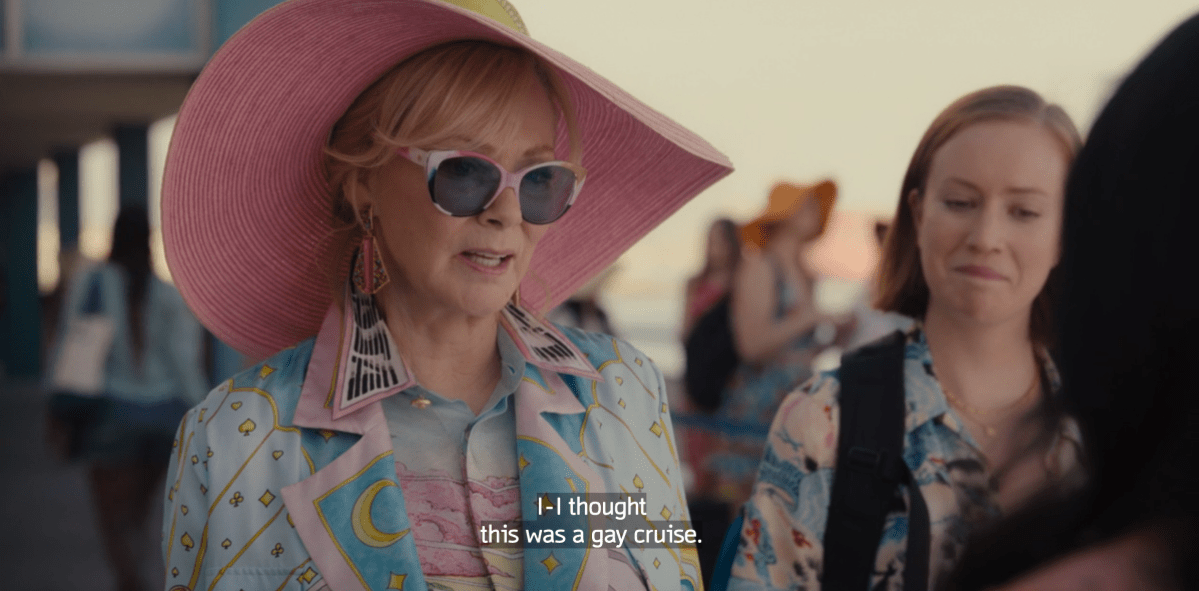Lauren Bacall's Lesbian Villain Is Also A Hero
'Young Man With a Horn' (1950) tries to tell us to be queer is to be crazed, but does it succeed?
This is the Sunday Edition of Paging Dr. Lesbian. If you like this type of thing, subscribe, and share it with your friends. Upgrade your subscription for more, including weekly dispatches from the lesbian internet, monthly playlists, and a free sticker. I’m a full-time freelance journalist – your support goes a long way!
Today, I’m continuing my impromptu series about Old Hollywood lesbians. Our film this week is Young Man With a Horn (1950), in which Kirk Douglas plays an obsessive trumpet player, Doris Day a sweet-faced singer, and Lauren Bacall an enigmatic lesbian.
Based on Dorothy Baker’s novel of the same name, the film follows the life story of Rick (Douglas), a trumpet player who loves music more than anything in the world. Jazz musician Art Hazzard (Juano Hernandez) introduces Rick to the instrument as a child, helping him improve his craft until he is good enough to make it big. He meets Jo (Day), an open-hearted singer intrigued by Rick’s rebellious creative spirit. We watch Rick through his coming of age, his successes, and his eventual downfall.
For our purposes, the most important character in the film is Amy, played by Lauren Bacall. A friend of Jo’s, Amy is a well-to-do woman training to become a psychologist. Her inaugural scene in the film tells us almost everything we need to know about the character. In a glamorous movie star entrance, Bacall walks down the stairs of the jazz club and poses in front of the mirror. As such, the first time we glimpse Amy’s full countenance, there are two of her. Here, we’re introduced to the characteristic that most defines Amy: the notion that she is torn between two things at once, that she has two selves (perhaps one public, and one private), or, less charitably, that she’s two-faced.
When she meets Rick, we witness her unusual dynamic with men. She leans back against the bar, both seductive and cocksure. She’s positioned here as the aggressor, while Rick is merely the passive recipient of her attention. When Jo describes Amy to Rick, we’re told she’s not exactly normal. “She always talks like a medical book and likes to analyze everything,” Jo says, referring to her interest in psychology.
Moments later, Amy muses about the differences between her and Jo, in one of her most memorable – and telling – lines in the film. “Jo’s interesting, isn’t she? So simple and uncomplicated. Must be wonderful to wake up in the morning and know just which door you’re going to walk through. She’s so terribly normal,” Amy tells Rick.
Even the lighting highlights (literally) the differences between the two women. Jo is almost always shot in high-key lighting, her face evenly lit. On the other hand, Amy often appears among shadows, only half of her striking face illuminated. This dialogue and these lighting cues tell us that Amy is not like other women, especially Jo. She has multiple sides, she can’t make up her mind, she’s complicated, and mysterious. Her introductory scene gives us a clear indication that there is something very queer about Amy indeed.
Amy and Rick’s first evening together is similarly odd. Amy takes him back to her luxurious apartment after their night out on the town. Her home is filled with partially clothed Grecian statues of women, and all of her paintings depict women as well. Her best friend is a pet cockatoo named Louise. Once again, she is the more active participant in this dynamic. She pours Rick an incredibly strong drink, but then suddenly decides she needs to go to bed, leaving him bewildered. She’s confounding, certainly, and also unexpected. She embodies an inversion of gendered roles, a callback to the theory of inverts that defined “research” on homosexuality around the turn of the century. Yet she is not depicted as masculine, or laughable, or inherently evil – at least not yet.
When we learn more about Amy’s history, a queer psycholgical profile emerges – an ironic turn of events considering Amy’s chosen profession. She tells Rick she has “no use for her father,” a statement that Freud and his fellow psychoanalysts would have a field day with. She reveals that her mother committed suicide when she was 12, changing her life forever. In the 1940s and 1950s, one common explanation for homosexuality was childhood trauma – some event or experience that irrevocably changes a person. Though this connection is never made outright, we’re often told that Amy is damaged or broken inside, perhaps due to her childhood, which is also the reason for her deviance.
When Rick and Amy grow closer, he gets his first inkling that Amy is not what she seems. When he kisses her, she pulls away, telling him, “It’s not you.” When Rick confesses his love for Amy, she tells him he can’t love her because she doesn’t respect herself enough. Frustrated by her erratic behavior, Rick exclaims, “What am I, some kind of experiment?” One imagines that this line is a more obvious reference to sexuality today than it would have been in 1950, but either way, it’s clear her heart isn’t in it. Leaving Rick’s apartment, we get another shot of Amy in the mirror on the elevator, indicating her deceptive, distant nature hasn’t subsided.
For some reason, Rick and Amy still decide to get married. Jo doesn’t approve, and she comes to Rick’s apartment to tell him as much. “She’s a strange girl, and you’ve never known anyone like her before,” Jo notes, suggesting that this is the reason for Rick’s initial attraction to her. But, she goes on, “Inside, way inside, she’s all mixed-up. She’s wrong for you, Rick. She’ll hurt you.” Jo is on to something, but Rick refuses to hear it, despite the many indications we’ve already seen that Amy is mixed up inside.
Unsurprisingly, marriage doesn’t go well for them. At first, they stay out all night and sleep all day, living a musician’s lifestyle. But Amy feels like she has no purpose, so she goes back to school for psychology. Now their schedules are at odds, as Rick works in the evening and Amy during the day. (Thankfully, as was the Hollywood custom during this period, they have separate beds.)
After weeks of not communicating, things come to a head. When they finally have a conversation, Amy confesses she does not want to be there anymore, perhaps because she’s met someone she’s more compatible with. “I met a girl the other day, an artist. Maybe we’ll go to Paris together,” she tells Rick, revealing that she flunked out of school weeks ago. (To make a not-so-wild leap, it appears that instead of studying psychology, Amy has been studying lesbianism.) Rick asks why Amy married him in the first place, and she responds, “How do you know about anything until you try it?” – a callback to his previous comment about experimentation.
Shortly thereafter, their estrangement becomes final. Her artist “friend” comes to her cocktail party and invites Amy over for dinner and back to her place afterward. (To see her paintings, of course. Nothing untoward.) After the guests leave, Rick and Amy get into a screaming match. Rick tells Amy that she’s a “sick girl” who needs to see a doctor. He compares her to a carnival joint – “Big flash on the outside, but on the inside nothing but filth.”
But Amy’s no longer a woman lacking self-respect. “I’m not confused any longer,” she exclaims. “I’m fed up with you. I’m sick of you trying to touch me.” She seems to have discovered what makes her happy, and it’s not Rick. The only new thing in her life since she married Rick is her artist friend, and she still hasn’t landed on a profession – are we not to believe the artist helped Amy overcome her confusion?
Their fight is the last time we see Amy. (Rick, despite his downward spiral, gets a redemption arc not included in the book.) From a purely narrative standpoint, Amy is the closest thing the film has to a villain. The New York Times called the character a “disagreeable part” and described her as a “confused, mentally sick wife.” She’s certainly an adversary of Rick’s. But from a modern perspective, her story is not one of betrayal, but of a woman finding herself. For queer viewers, she might appear as a triumphant figure. She’s not given a happy ending, but her journey doesn’t end in tragedy either, the typical fate of queer or queer-coded characters from this period. Indeed, it’s easy enough to imagine her story continuing off-screen, perhaps traveling to Paris with her artist companion after all.
While Young Man With a Horn isn’t a film noir, Amy displays all the characteristics of a femme fatale. She stands in the way of her husband’s ambitions, and her motives are murky. Her queerness makes her more of a femme fatale. In Queer Images by Harry M. Benshoff and Sean Griffin, they write that “Occasionally, such women were presented as especially ominous because of their lack of romantic interest in men.”
Though presented as a villain, Amy’s deviance looks different than queer-coded characters of previous decades. As Benshoff and Griffin write, “Queer characters in postwar Hollywood films not only shifted from silly to villainous; they also increasingly moved away from the idea of homosexuality as gender inversion.” Queer figures like Amy were now less likely to be indenetified as queer based on their appearance or clothing, a more frightening prospect for a homophobic public.
Nonetheless, there were several masculine-looking characters in the 1950s that appealed to lesbians due to their gender presentation. Though Doris Day plays an exceedingly normal, all-American girl in Young Man With a Horn, in 1953’s Calamity Jane, she played a gunslinging tomboy. And in Johnny Guitar, released in 1954, Joan Crawford played a butch-of-center cowgirl beloved by lesbian viewers.
In Young Man With a Horn, Bacall appeals differently to lesbian and queer viewers. Bacall unquestionably has one of the most beautiful faces to ever grace the screen, and in this picture, she’s as elegant as ever, even while the film tells us that she’s sick on the inside. (Perhaps this dichotomy – a beautiful exterior and a “rotten” interior – is meant to make Amy appear more dangerous.)
Queer viewers must have read against the grain when engaging with Amy, and one imagines there was a distinct delight in seeing a movie star like Bacall play such a tenacious character. The story not shown on screen, the one where Amy lives her life as a bohemian lesbian in Europe, exists only in the minds of these viewers, passed down to us through the decades.
the ship that never sinks
No, it's not friendship. Plus, who did something gay on the cover of a magazine, and why did a straight woman write a lesbian book?


